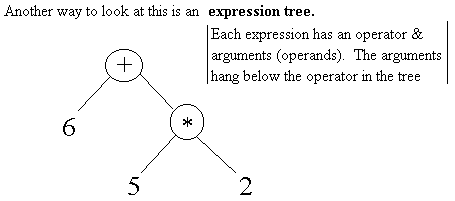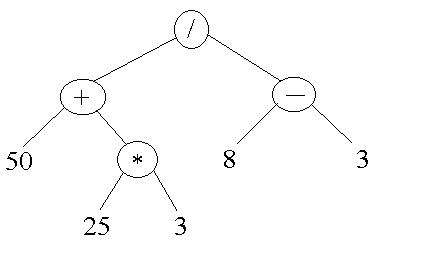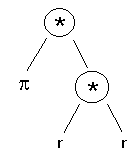CSE131: Data Types and Expressions
Copyright © 1996-2005, Kenneth J. Goldman
Everything in Java has a type that identifies the "kind of thing" it is.
Some primitive (built-in) data types in Java are:
int -- an Integer, like 5, -37, 256, 0
double -- an decimal number, like 3.14159, 0.25
boolean -- true or false
String -- a string of characters, like "hello world"
+.
The syntax is infix, meaning that the operators go in between the
operands, the values upon which they operate.
For example, let's look at some integer expressions.
| Expression | Value |
|---|---|
3 + 5 | 8 |
17 - (3 * 5) | 2 |
8 / -2 | -4 |
14 % 3 | 2 (modulus or remainder) |
6 + 5 * 2 | 16 |
These are precedence rules, sometimes called
order of operations.
Expression Trees
One way to think about an expression is with an expression
tree, where the operands hang below their operator in the tree.
The last calculation to be performed is at the top (root) of
the tree. For example, consider the expression
6 + 5 * 2.

Now, consider (50 + 25 * 3) / (8 - 3).
What's the last operation to be performed?
Division. So we put the division operator
at the top of the tree. The operands of the division are the
values of the addition and subtraction expressions, and so on.
Thus, we get the following expression tree.

Java evaluates left to right and bottom to top in this tree. Operands are always evaluated before the operation is performed.
One way to evaluate an expression tree is to work your way up,
writing by each node the value that results from performing that
operation on the child operands. Consider the tree above. For the
multiplication node, we get 75. Then, for the addition node, we have
operands 50 and 75, yeilding 125. For the subtraction node, we have
5. Finally, at the top we have 125 divided by 5, resulting in 25 as
the final value of the expression.
Substitution Model
Using the substitution model, you replace expressions by simpler
expressions or values until reaching a final value. For example,
(50 + 25 * 3) / (8 - 3)
(50 + 75 ) / 5
125 / 5
5
Notice the similarity between this method and the evaluation of
expression trees.
Notes:
If you mix int and double values in
an expression, the result is a double.
Division by zero is considered an error.
For example,
| Expression | Value |
|---|---|
7.0 / 2 | 3.5 |
7 / 2 | 3 (value is truncated) |
7 % 2 | 1 |
7 / (4 - 2 * 2) | error (division by 0) |
+ for concatenation of strings.
| Expression | Value |
|---|---|
"abc" + "def" | "abcdef" |
"123" + "456" | "123456" (not 579) |
"hello" + "world" | "helloworld" |
"hello " + "world" | "hello world" |
Java will convert other primitive values to strings in a concatenation.
| Expression | Value |
|---|---|
"abc" + 123 | "abc123" |
123 + "abc" | "123abc" |
"123" + 456 | "123456" |
123 + 456 | 579 |
| Expression | Value |
|---|---|
3 == 3 | true (test for equality) |
3 != 3 | false (test for inequality) |
7 > 3 | true |
!(7 > 3) | false |
(7 > 3) || (7 <= 3) | true |
(7 >= 3) && (7 < 3) | false |
int n; double y;are declarations for an integer variable
n and a
double y. Think of a variable as a container with the
"right shape" to hold a value of the declared type. We put a value
into a variable using an assignment statement.
For example,
n = 3; y = 0.95 * 200; n = 5;would put the values 3 and 190 into the two variables, respectively. Then, the value in variable
n would be overwritten with
the value 5.
In general, a statement is a step to be executed in a computer program. In Java, both statements and declarations end with semicolons (;). Unless otherwise directed, Java executes statements in order, one after another.
In an assignment statement, the expression on the right is evaluated and then assigned to the variable on the left. The types must be compatible. For example,
int k; k = "foo"; // ERROR -- type mismatchFor convenience, Java allows a declaration to be combined with an assignment on the same line, giving the declared variable an initial value. For example,
int i = 3; // declares an integer variable i and initializes it to 3Variables may take on new values as the result of subsequent assignment statements:
int j = 4; // declares an integer variable j and initializes it to 4 j = 2; // changes the value of j to 2Note: To prevent a variable ever being changed from its initial value, one may use Java's final modifier.
final double PI = 3.14159; PI = 6; // ERRORWe use uppercase for final variables (by convention). A final variable is often called a constant.
Using symbols in place of values and giving names to particular values are two forms of naming abstraction. The power of naming abstraction should not be underestimated. It saves us from retyping to the value all the time and makes programs easier to read.
People use names all the time to make our lives easier. Imagine if none of us had names, and we had to refer to people by description! ("The guy with brown hair and glasses.") Similarly, imagine if we all had one-letter names or unpronouncable names for objects. We choose names for their convenience and their descriptive power.
Just as in real life, it's important to choose meaningful names for
variables and other things in a computer program. The computer
doesn't care what names you pick, but it makes a huge difference to
people who need to read your program. When you or someone else tries to
modify your program later, having descriptive names that convey the
purpose of the variable to the reader is extremely important.
Using Variables in Expressions
Suppose we want to compute the area of some circles with radii 3, 4, and 5.

Expression tree:

To accomplish this task, we could write the expressions:
double area3 = 3.14159 * 3 * 3; double area4 = 3.14159 * 4 * 4; double area5 = 3.14159 * 5 * 5;
But this is annoying! We're doing a lot of the same thing over and over. Specifically, we have to keep typing the value of pi over and over, and we must type the radius twice each time in order to square its value. Whenever you see a lot of repetetive work, it should clue you in that you need to use some kind of abstraction.
So far, we know about one means of abstraction, naming, so let's try to improve the situation using naming abstraction. We can use variable names in the formula instead of numbers, as follows.
final double PI = 3.14159; int r = 3; double area3 = PI * r * r; r = 4; double area5 = PI * r * r; r = 5; double area5 = PI * r * r;In some ways this is better. We need only provide the value of pi once, and each radius is provided once. Furthermore, we can tell more easily what the formula means because descriptive variable names are used.
However, we still have to remember the formula and type it each time we want to compute the area of a circle.
There must be a better way...